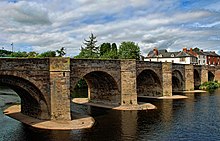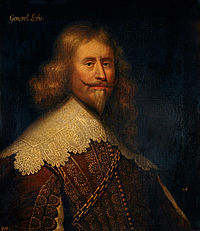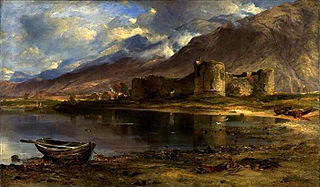
1645 (MDCXLV) was a common year starting on Sunday of the Gregorian calendar and a common year starting on Wednesday of the Julian calendar, the 1645th year of the Common Era (CE) and Anno Domini (AD) designations, the 645th year of the 2nd millennium, the 45th year of the 17th century, and the 6th year of the 1640s decade. As of the start of 1645, the Gregorian calendar was 10 days ahead of the Julian calendar, which remained in localized use until 1923.

The Battle of Marston Moor was fought on 2 July 1644, during the Wars of the Three Kingdoms of 1639–1653. The combined forces of the English Parliamentarians under Lord Fairfax and the Earl of Manchester and the Scottish Covenanters under the Earl of Leven defeated the Royalists commanded by Prince Rupert of the Rhine and the Marquess of Newcastle.

The Battle of Naseby took place on 14 June 1645 during the First English Civil War, near the village of Naseby in Northamptonshire. The Parliamentarian New Model Army, commanded by Sir Thomas Fairfax and Oliver Cromwell, destroyed the main Royalist army under Charles I and Prince Rupert. The defeat ended any real hope of royalist victory, although Charles did not finally surrender until May 1646.
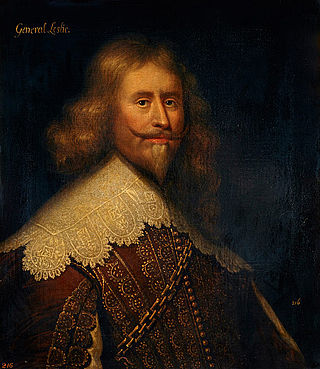
Alexander Leslie, 1st Earl of Leven was a Scottish military officer and peer. Born illegitimate and raised as a foster child, he subsequently advanced to the rank of field marshal in Swedish Army, and in Scotland became Lord General in command of the Army of the Covenanters, a privy councillor, captain of Edinburgh Castle, Lord Balgonie and Earl of Leven. In England he commanded the Army of the Solemn League and Covenant and was senior commander of the Army of Both Kingdoms (1642–1647). Leslie served in the Thirty Years' War, the Bishops' Wars, and most of the English Civil War, fighting primarily in the First English Civil War. Leslie would live a long life, dying roughly at the age of 80 or 81.

David Leslie, 1st Lord Newark was a Scottish military officer and peer. During the Thirty Years' War, he joined in the Swedish Army in 1630 and served under Alexander Leslie. Returning to Scotland in the final days of the Bishops' War, Leslie fought in the English Civil War and Scottish Civil Wars on the side of the Covenanters and Royalists. After the Stuart Restoration, Leslie was raised to the peerage of Scotland as Lord Newark by Charles II of Scotland.

The First English Civil War took place in England and Wales from 1642 to 1646, and forms part of the 1639 to 1653 Wars of the Three Kingdoms. An estimated 15% to 20% of adult males in England and Wales served in the military at some point between 1639 and 1653, while around 4% of the total population died from war-related causes. These figures illustrate the widespread impact of the conflict on society, and the bitterness it engendered as a result.
General William Baillie was a Scottish professional soldier who fought for the Dutch and later commanded a regiment under Gustavus Adolphus in Sweden. Previously having seen service in the Scots-Dutch brigade, he joined the Scottish regiment of Colonel Alexander Hamilton in Sweden before going on to command a German regiment. Records of his service in the Swedish army fade out after 1633. He returned to Scotland in 1639. He served with the Army of the Covenant in 1639 at Duns Law with the rank of colonel.

The Battle of Kilsyth, fought on 15 August 1645 near Kilsyth, was an engagement of the Wars of the Three Kingdoms. The largest battle of the conflict in Scotland, it resulted in victory for the Royalist general Montrose over the forces of the Covenanter-dominated Scottish Parliament, and marked the end of General William Baillie's pursuit of the Royalists.
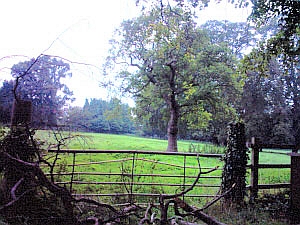
The Battle of Rowton Heath, also known as the Battle of Rowton Moor, occurred on 24 September 1645 during the English Civil War. The Parliamentarians, commanded by Sydnam Poyntz, inflicted a significant defeat on the Royalists under the personal command of King Charles I, inflicting heavy losses and preventing Charles from relieving the siege of Chester.

James King, 1st Lord Eythin (1589–1652) was a Scottish soldier, who served in the Swedish army, and who later supported King Charles I in the Bishops' Wars, and then later in the English Civil War.
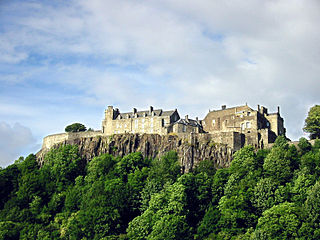
The second Battle of Stirling was fought on 12 September 1648 during the Scottish Civil War of the 17th century. The battle was fought between the Engagers who were a faction of the Scottish Covenanters under the command of George Munro, 1st of Newmore and who had made "The Engagement" with Charles I of England in December 1647, against the Kirk Party who were a radical Presbyterian faction of the Scottish Covenanters who were under the command of Archibald Campbell, 1st Marquess of Argyll.
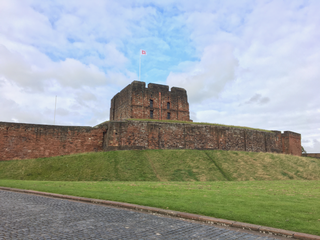
The siege of Carlisle occurred during the First English Civil War when the allied forces of the Scottish Covenanters and the English Parliamentarians besieged Carlisle Castle which was held at the time by the English Royalist forces loyal to King Charles I. The siege took place in Carlisle, Cumbria from October 1644 to 25 June 1645.
The ordinance of no quarter to the Irish was a decree of the English Long Parliament passed on 24 October 1644 in response to the Irish Catholic Confederation threat to send troops from Ireland to support King Charles I during the English Civil War. The decree ordered Parliamentary officers to give no quarter to Irish soldiers fighting in England and Wales, and Irish Confederate sailors at sea who surrendered.
1645 was the fourth year of the First English Civil War. By the beginning of 1645 the war was going badly for Charles I and the campaigns of 1645 did not see a recovery in his prospects.
Fitzwilliam Coningsby was an English politician who sat in the House of Commons in 1621 and in 1640. He supported the Royalist cause in the English Civil War.
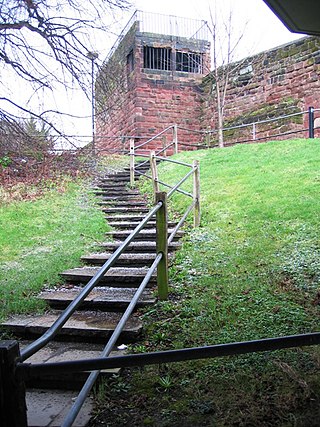
The siege of Chester occurred over a 16-month period between September 1644 and February 1646 during the First English Civil War. In the engagement, Sir William Brereton and the Parliamentarians were ultimately successful in taking possession of the city and Royalist garrison commanded by Lord Byron.

The siege of Newcastle occurred during the First English Civil War, when a Covenanter army under the command of Lord General Alexander Leslie, 1st Earl of Leven besieged the Royalist garrison under Sir John Marlay, the city's governor. Eventually, the Covenanters took the city of Newcastle upon Tyne by storm, and the Royalist garrison who still held castle keep surrendered on terms.
Colonel John Cockburn was an officer in the Scottish Covenanter army in the late 1640s and early 1650s during the Wars of the Three Kingdoms. In this capacity he led Lowland soldiers against Montrose's Scottish Royalist forces during the First English Civil War (1642-1646), when the Covenanter parliament of Scotland was allied with the English Parliamentarians against King Charles I. Colonel Cockburn led the colourfully defiant but futile Scottish resistance at Hume Castle during the Third English Civil War (1649-1651), when a Parliamentary army led by Oliver Cromwell invaded Scotland after its Covenanter government had made an uneasy alliance with King Charles II.
The Battle of Sherburn in Elmet was an action fought towards the end of the First English Civil War. A detachment of the English Royalist army led by Lord Digby, King Charles I's Secretary of State, was making a belated attempt to reach Scotland and join forces with the Scottish Royalists. As they moved north through Yorkshire, they were pursued by a Parliamentarian force under Sydnam Poyntz. Poyntz was unaware of the Royalists' position, and the Royalists took the opportunity to ambush and attack a small Parliamentarian detachment at night in the village of Sherburn in Elmet. However, the Royalists then mistook fleeing Parliamentarians for their own men and panicked. In the ensuing flight, several hundred Royalist prisoners were taken. The Parliamentarians also captured Digby's coach, which contained much compromising correspondence.
Sir Barnabas Scudamore (1609–1651) was an English military commander and active Royalist during the English Civil War. The son of James Scudamore and younger brother of Viscount Scudamore, he was from a prominent Herefordshire landowning family. His family's seat was at Holme Lacy.
